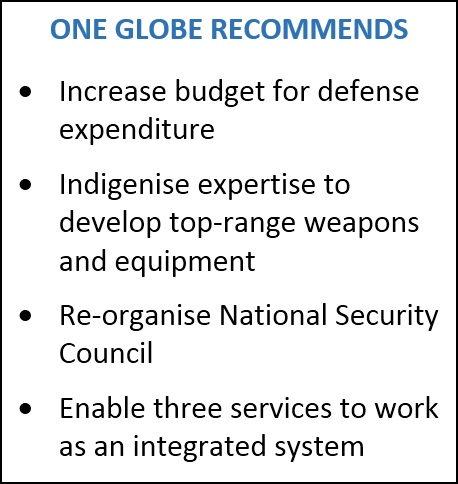India needs scientific and strategic expertise to meet security challenges
Posted by Admin on December 20, 2017
 |
During the One Globe Forum 2017, the panel on ‘Modernising India’s Defense and Security Capabilities for the 21st century’ began with an analysis of this year’s budget.
On 1st Feb, the government announced the Defense budget for this year. US$ 53.5 billion were allotted to the sector. As Mr. T.C.A. Rangachari, former Ambassador of India to France and Germany, suggested, while the figure seems substantial it warrants a closer look. Within the budget, pension and capital expenditure were accorded an equal share – approximately 86,000 crores each. Again, the defense share of the GDP this year is 1.56% - the lowest since 1956-57. The combined share of stores and capital modernization declined from 55% to in 1956-57 to 40% in 2016-17. While some of this rollback can be adjusted against India’s GDP growth, it is still considerable given that defense is a crucial sector for a country like India.
To the north and the west, India struggles with unsettled borders. Also, Chinese assertion is visible in India’s waters. There is substantial evidence for the ‘String of Pearls’ theory. China has established choke points on key lines of communication in the Straits of Malacca, Hormuz, Lombok and others.
Within the country, as stated by General Deepak Kapoor, Former Chief of Army Staff, has faced the challenge of terrorism, natural disasters, insurgency in the North-east, proxy war in J&K, and left-wing extremism in different parts. “The best organization, which is ready to respond to such eventualities is the defense establishment,” he said.
To ensure India’s territorial integrity and enable it to progress peacefully, the defense requires ‘multispectrum capability’. Gen. Kapoor mentioned the need for A-grade equipment to carry out tasks such as surveillance, precision-targeting, night-fighting, communications, and obtaining real-time intelligence.
Comparing China’s defense budget for 2017, which is approximately $ 151 billion this year, Gen Kapoor noted that “The current level of defense budgets [is] too low to ensure meaningful modernization.” Not only because the challenges facing the Indian armed forces are tremendous, but because of the price escalation in the global arms industry.
Air Marshal Sumit Mukerji, Former Air Officer Commanding in Chief of the Indian Air Force, said that the lack of funds had led to the depletion of fighter squadrons in the Air Force jeopardizing national security. He said, “A very typical question that keeps coming to us is that ‘look, you guys are constantly buying from outside. Why not use Indian material?’ I wish it was there.”
He said that the lack of scientific precision and expertise within the country had amplified the budget woes of the forces. And there was a strong need for support from the government and related agencies to produce viable systems and equipment, which could offset budgetary cuts, and create a steady supply chain. “The Air Force is desperately looking for indigenization. You know, we are so dependent on the spares flow. As the Army calls it, the ‘tooth to tail’ ratio. You have to keep the supply chain running. If you’re constantly buying stuff from outside, there’s always a chance of disruption. God forbid there are sanctions put against you.”
Vice Admiral Shekhar Sinha, Former FOC, Western Naval Command, said that he did not think the government was oblivious to India’s defense challenges, “Our politicians are very sharp people who understand the security challenges. I think it’s the implementation which is where we are faltering.” He urged a restructuring of the National Security Council.
“The National Security Council structure has to be redone. A country as big as India cannot have the structure we have right now.” He emphasized that to countermand challenges, India has a need for adequately calibrated inputs.
To back his suggestion, he quoted Kautilya’s theory of statecraft saying, “Power is not measured entirely in terms of military power but also by intellectual and moral power.” To modernize, and convert India’s potential power into a real one, “there is need for an effective response mechanism.”
Vice Admiral Sinha suggested a new organization for the National Security Council, with 4 wings, each headed by a Deputy NSA level officer. The wings would deal with current and emergent security challenges, such as economic security, cyber security, intelligence, and others. Air Marshal Mukerji concurred on the reorganization and added, “We need to reorganize our higher defense organization. . . The three services must work as an integrated system. It has to be pushed by the government so that the integration is adequate and meets the requirement of national security.”
India cannot ignore its defense sector if it wants to progress in peace, and maintain its borders. Increasing military spend, developing indigenous expertise, and reorganizing the NSC, are strategic ways through which India can empower its forces and, consequently, itself.








